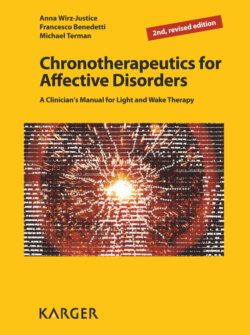Читать книгу Chronotherapeutics for Affective Disorders - M. Terman - Страница 20
На сайте Литреса книга снята с продажи.
1.10 How Does Chronotherapeutics Work?
ОглавлениеDetailed reviews with references can be found in [57, 58]. Here, we summarise the main arguments. Sleep deprivation targets several mechanisms common to the action of antidepressant drugs, potentiating all the same monoaminergic systems. Converging results from direct measurements in animal models and from studies in humans, using biological challenges and pharmacogenetic approaches, show that wake therapy acts on brain 5HT, NA, DA, glutamate, and adenosine, and that changes in the activity of these neurotransmitters and their signalling cascades are proportional to the observed behavioural effects. Gene variants that improve neurotransmission by increasing 5HT2A receptor or 5HT transporter density, or decrease neurotransmitter degradation via catechol- O-methyltransferase, also improve clinical efficacy of wake therapy in bipolar depression when given alone or combined with bright light. These genet-ic influences have effect sizes comparable to those observed with response to antidepressant drugs, strongly suggesting a shared mechanism of action. Support for this comes from synergistic interactions of wake or light therapy with drugs. In addition, wake therapy modulates glutamatergic transmission in the anterior cingulate cortex, a brain area implicated as a neural basis for mood-congruent cognitive biases in depression, the changes being proportional to mood amelioration. Moreover, all neurotransmitter systems undergo strong circadian and seasonal rhythms, and are affected by light. Chronotherapeutic interventions phase advance and stabilise circadian rhythms, which may be a main mechanism of action at the behavioural level.
At the molecular level, growing evidence supports the hypothesis that changes in brain monoaminergic functioning influence circadian genes, and that some genetic variants of the same clock genes are associated with a worse bipolar phenotype. Clock genes are expressed in many brain structures other than in the SCN , and their genetic variants can bias ‘non-clock’ brain functions such as information processing and decision making in bipolar depression. Several findings suggest that clock genes could provide a mechanism for control of circadian gene expression and of responsiveness to stimuli, which in psychiatric conditions may influence the complex relationship between susceptibility and precipitating factors for depression, thus biasing core characteristics of the illness such as age at onset, recurrence of illness, or its occurrence in specific risk periods such as postpartum.
A close link between the clock machinery and core metabolic cellular processes has been established by the study of protein modulators such as glycogen synthase kinase 3-β (GSK3-β), which is a core constituent of the mammalian circadian clock and affects circadian rhythm generation by modifying the stability of circadian clock molecules. Increasing GSK 3-β augments susceptibility of neurons to harmful stimuli, whereas inhibiting GSK 3-β has neuroprotective effects, because its inhibition occurs in response to brain-derived neurotrophic factor and other neurotrophins. These mechanisms provide a target for the convergent effects of chronotherapeutics and antidepressant drugs on the biological clock and on neurotransmitter systems. Control of the phosphorylation/activity status of GSK 3-β is considered an important mechanism of 5HT and DA action on brain and behaviour because GSK 3-β is inhibited by lithium, valproate, SSRIs , MAO-inhibitors, and TCAs . In bipolar disorder, promoter gene variants are associated with less detrimental clinical features including a later onset of illness and a better clinical response to lithium and wake therapy.
Molecular mechanisms involved in brain plasticity are likely to play a major role in antidepressant response and long-term mood stabilisation of bipolar patients. Accumulating evidence suggests that plastic processes occurring during wakefulness result in a net increase in synaptic strength in many brain circuits, and that synaptic strength is downscaled to baseline levels during sleep, when effective cortico-cortical connectivity is broken down. Support for this ‘synaptic homeostasis hypothesis’ of sleep comes from a steady increase in the excitability of human cortical circuits during prolonged wakefulness that is reduced during sleep.
Effective chronotherapeutics has been shown to rapidly reverse and normalise mood-congruent cognitive biases which facilitate neuropsychological response toward negative stimuli in depression. In conclusion, the mechanism of the antidepressant action of chronotherapeutics involves marked changes in the neurobiology of the brain, involving multiple targets which have been linked with depression and recovery, even though there is still a high level of uncertainty about which biological changes are needed to recover from a major depressive episode.
